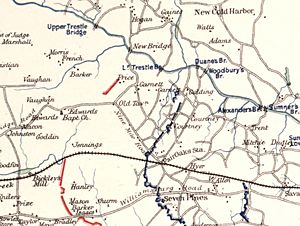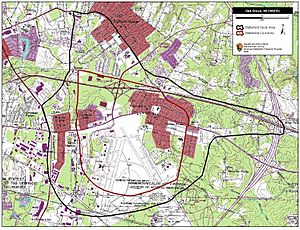Battle of Oak Grove facts for kids
Quick facts for kids Battle of Oak Grove |
|||||||
|---|---|---|---|---|---|---|---|
| Part of the American Civil War | |||||||
 Old Tavern area |
|||||||
|
|||||||
| Belligerents | |||||||
| Commanders and leaders | |||||||
| George B. McClellan Samuel P. Heintzelman |
Robert E. Lee Benjamin Huger |
||||||
| Units involved | |||||||
| III Corps (Army of the Potomac) |
Huger's Division (Army of Northern Virginia) |
||||||
| Strength | |||||||
| 3 Brigades | 1 Division | ||||||
| Casualties and losses | |||||||
| 626 total 68 killed 503 wounded 55 missing |
441 total 66 killed 362 wounded 13 missing |
||||||
The Battle of Oak Grove was the first major fight of the Seven Days Battles during the American Civil War. It happened on June 25, 1862, in Henrico County, Virginia. This battle was part of the Peninsula Campaign, where the Union Army tried to capture Richmond, the capital of the Confederate States.
Union Maj. Gen. George B. McClellan wanted to move his army closer to Richmond. His goal was to get his large cannons, called siege guns, within firing range of the city. Two Union divisions from the III Corps attacked across a swampy area. However, Confederate soldiers led by Maj. Gen. Benjamin Huger pushed them back. McClellan was about 3 miles (5 km) away from the fighting. He first ordered his troops to stop the attack, but then changed his mind and told them to attack again. The fighting continued until nightfall. In the end, the Union troops only gained about 600 yards (550 meters). More than a thousand soldiers from both sides were killed or wounded. The battle did not have a clear winner.
Contents
Why the Battle Happened
The Armies Get Ready
After a battle called Battle of Seven Pines in May and June 1862, the Union Army, led by General McClellan, stayed in its positions near Richmond. The new leader of the Confederate Army, General Robert E. Lee, used this time to get his army ready. He made his defenses stronger and planned to attack McClellan's larger army.
McClellan learned that Lee was preparing to move. He also heard that a famous Confederate general, Stonewall Jackson, and his troops were coming to help Lee. McClellan decided to attack first, before Lee could make his move. He sent out more cavalry (soldiers on horseback) to look for Jackson's approaching forces.
Union Plans for Attack
McClellan wanted to move his big siege cannons about a mile and a half closer to Richmond. To do this, he needed to capture a higher area near a place called Old Tavern. As a first step, he planned an attack on Oak Grove. This area was south of Old Tavern and had been a place where small fights had happened before. Oak Grove was known for its tall oak trees.
The Union attack was planned to move west, towards Richmond, along a road called Williamsburg Road. Between the two armies was a thick forest, about 1,200 yards (1,100 meters) wide. A small swamp, called White Oak Swamp, ran through this forest. Two divisions from the Union III Corps were chosen for the attack. These divisions were led by Brig. Gens. Joseph Hooker and Philip Kearny. Facing them was the Confederate division of Maj. Gen. Benjamin Huger.
The Battle Begins
The battle started at 8:30 a.m. on June 25. Three Union brigades (groups of soldiers) began their attack in an organized line. From right to left, they were led by Brig. Gen. Daniel Sickles, Brig. Gen. Cuvier Grover, and Brig. Gen. John C. Robinson.
Robinson and Grover's brigades moved forward well at first. But Sickles's soldiers had a tough time. They had to get through fallen trees (called abatis) and then through the swampy parts of White Oak Swamp. They also met strong Confederate resistance. This caused the Union line to become disorganized.
Confederate Counterattack
The Confederate commander, Huger, saw the confusion in the Union lines. He quickly launched a counterattack. Brig. Gen. Ambrose R. Wright led his Confederate brigade against Grover's Union brigade.
Things got even more confusing because one of Wright's Georgia regiments wore red uniforms, like the French Zouave soldiers. Many of Grover's men thought that only the Union Army had Zouave units. So, they were slow to fire, thinking they might be shooting at their own side. Once they realized these were Confederate troops, they started firing.
At a key moment, the 26th North Carolina regiment, fighting for the first time, fired a perfectly timed volley of shots. This hit Sickles's brigade hard, causing the 71st New York regiment to panic and run away. Sickles later called this a "disgraceful confusion."
McClellan's Orders
The Union corps commander, Heintzelman, heard about Sickles's retreat. He sent more troops forward and told General McClellan what was happening. McClellan was trying to manage the battle from 3 miles (5 km) away using a telegraph. He became worried and, at 10:30 a.m., ordered his men to pull back to their starting positions. This order confused his officers who were at the front.
McClellan then telegraphed that he would come to the front himself. This caused a 2.5-hour break in the fighting. When he arrived at 1 p.m., McClellan saw that the situation was not as bad as he had feared. He then ordered his troops to attack again and retake the ground they had already fought for earlier that day. The fighting continued until nightfall.
What Happened Next
The Battle of Oak Grove was the only time McClellan's army attacked Richmond directly during this campaign. The Union army only gained about 600 yards (550 meters) of ground. Over 1,000 soldiers from both sides were killed or wounded. This small battle was not enough to stop General Robert E. Lee's plans.
The very next day, Lee launched his own attack at the Battle of Beaver Dam Creek. This battle was north of the Chickahominy River, near Mechanicsville. It was the first big battle of the Seven Days and marked the beginning of the Union Army's retreat.
Images for kids
See also
 In Spanish: Batalla de Oak Grove para niños
In Spanish: Batalla de Oak Grove para niños




